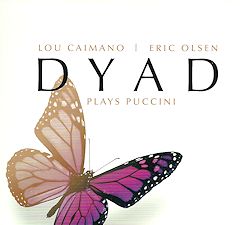1. Musetta's waltz
2. Ch'ella mi creda
3. Act I Overture (from Madam Butterfly)
4. Che gelida manina
5. In quelle trine morbide
6. O mio babbino caro
7. Un bel di
8. E lucevan le stelle
9. Chi il bel sogno di Doretta
10. Nessun dorma
Lou Caimano - Alto sax
Eric Olsen - Piano
One of my biggest disappointments with much jazz nowadays (and popular music in general) is that some musicians have forgotten how to write melodies. Why
do so many jazz artists still perform items from the Great American Songbook? Because such composers as Gershwin, Kern, Berlin and Porter knew how to write
memorable melodies (as well as tunes with interesting chord sequences which are ideal for improvising upon). So perhaps it is no surprise that saxist Lou
Caimano and pianist Eric Olsen have turned to one of the most melodic of all opera composers - Puccini - and interpreted some of his arias as jazz.
This album arose because Eric Olsen's wife Pamela commented that Lou Caimano's saxophone sounded like an opera singer. Lou's alto sax is thus ideal for
improvising on some of Puccini's most famous compositions. Who does not know such arias as Nessun dorma or Your Tiny Hand is Frozen (Che gelida manina)? Such familiar melodies are perfect as the foundation for duets between Lou and Eric, especially as
Lou's tone on the saxophone is pure and almost classical, and both men are experienced in jazz as well as the classics. Jazz saxist Paquito D'Rivera said
"Caimano and Olsen go back and forth through the borders between Classical and Jazz with the ease of a couple of North-Mexican coyotes crossing the Rio
Grande".
Olsen seems to be the slightly jazzier of the two, accompanying his companion with jazz chords (sometimes deliberately discordant) and supplying several
excellent solos. One of my favourite Puccini songs is Chi il bel sogno di Doretta (from La Rondine), where Olsen retains Puccini's
beautiful introduction. This is perhaps the loveliest tune on the album. By contrast, Nessun dorma is almost avant garde, as the piano goes
oriental and the saxophone takes off in all directions.
Some of the tunes are transformed miraculously. Musetta's Waltz (from La Bohème) becomes a jaunty jazz waltz, with gliding solos from
piano and sax. After some twisting and turning counterpoint, the Overture to the first act of Madama Butterfly turns into an outright
swinger, complete with stride piano. Other compositions are treated less jazzily: Che gelida manina (from La Bohème) is interpreted with
sensitive lyricism, while E lucevan le stelle (from Tosca) is treated with the kind of plaintive drama that suits this extremely
melodramatic opera.
The recording is radiantly clear and skilfully balanced. I highly recommend this album for its brilliant originality, its intriguing blend of classics and
jazz, and the breathtaking skill of the duettists.
Tony Augarde
www.augardebooks.co.uk
